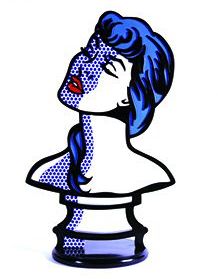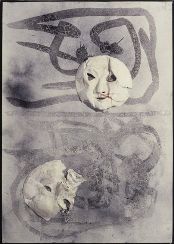
Fondazione Emilio e Annabianca Vedova
Roy Lichtenstein Sculptor
Spazio Vedova
Dorsoduro 50
30123 Venice, Italy
From 28th May to 24th November
The Fondazione Emilio e Annabianca Vedova will be hosting two extraordinary exhibitions at the Zattere from 28th May to 24th November: Roy Lichtenstein Sculptor, curated by Germano Celant at the Magazzino del Sale. With this new exhibition, the Fondazione continues in its approach of placing Vedova’s work in dialogue with that of leading exponents of contemporary art.
Roy Lichtenstein Sculptor
Considered one of the greatest exponents of American Pop art, the exhibition of Roy Lichtenstein’s work focuses on the sculptural production of
the artist.
Consisting of 45 works on loan from the Roy Lichtenstein Foundation in New York as well as from private collections it ranges from drawings, collages, sketches, wooden maquettes, bronze and a painted fiberglass sculpture made between 1965 and 1997. The collection of works is being presented in Europe for the first time to document the artist’s vast and complex sculptural production.
Lichtenstein’s interest in sculpture dates back to the 1940s, with experiments with carved wood and stone, terracotta and various assemblages some featuring painted-on layers of plywood, but it was not until 1964 that his sculptures began to reflect the mature language of his Pop idioms begun in 1961 when he started to use images drawn from the mass media, and from cartoons. Those paintings led to his interest in ceramic figurative works based on three-dimensional female mannequin heads and molds for piles of American diner style coffee cups and mugs and eventually to turning the two-dimensional explosions featured in Men at War comic serials into three-dimensional forms. These were all motifs transferred from a popular iconic source, initially insignificant and with no aesthetic character, to which the artist gave an artistic value, as though they were constants within a modernist culture leading from Brancusi to Calder. This theme was developed until his premature death in 1997 via dozens and dozens of sculptures oscillating between various styles that informed his production after the Sixties.
A constant in this activity was the stress on surface in his sculptures, but after 1965, the flattening treatment of the volume became more pronounced with his introduction of Art Deco style pieces begun in 1967 fabricated in brass with glass elements that evoked the stair railings and décor of New York City’s Radio City Music Hall. After 1976, a similar procedure led to “profile” sculptures, in which the depth and shadows of the object treated – a lamp, a mirror or coffee pot, or a face, nude or house – are all placed on the same plane, as though they were crushed and flattened on a single surface. Volume is transformed into compact line and colour, despite its depth often only being an inch thick, as though his sculpture had been cut-out from a newspaper or magazine.
This attunes them to the artist’s paintings, in which perspective differences are cancelled in favour of a play of full and void, transparency and opacity, leaving no room for any sense of depth, if not the insignificant flatness of the message drawn from the cartoon or the history of art.
This reflection on the two-dimensional vision is critique of the heroic gesture which underlies the dramatic, spectacular brushwork of the Abstract Expressionists. Lichtenstein’s sculptures are both rich in irony and visual refinements where the popular image overcomes its banality to affirm itself as a sublime treatise on popular culture.
Skira Editore will be publishing a catalogue edited by Germano Celant and including a foreword by Dorothy Lichtenstein and Jack Cowart and texts
by Alfredo Bianchini, Clare Bell and Ian Wallace, it illustrates the complex, rich evolution of Roy Lichtenstein as sculptor and contains some of his
own declarations about his work.
The exhibition layout is by Francesca Fenaroli of the Studio Gae Aulenti Associati, Milan.
Fondazione Emilio e Annabianca Vedova
Dorsoduro 42, Calle dello Squero
30123 Venezia, Italia
tel +39 041 5226626
fax +39 041 5239060
www.fondazionevedova.org
Press office
Studio Systema
tel +39 041 5201959
fax +39 041 5201960
stampa.vedova@studiosystema.it



